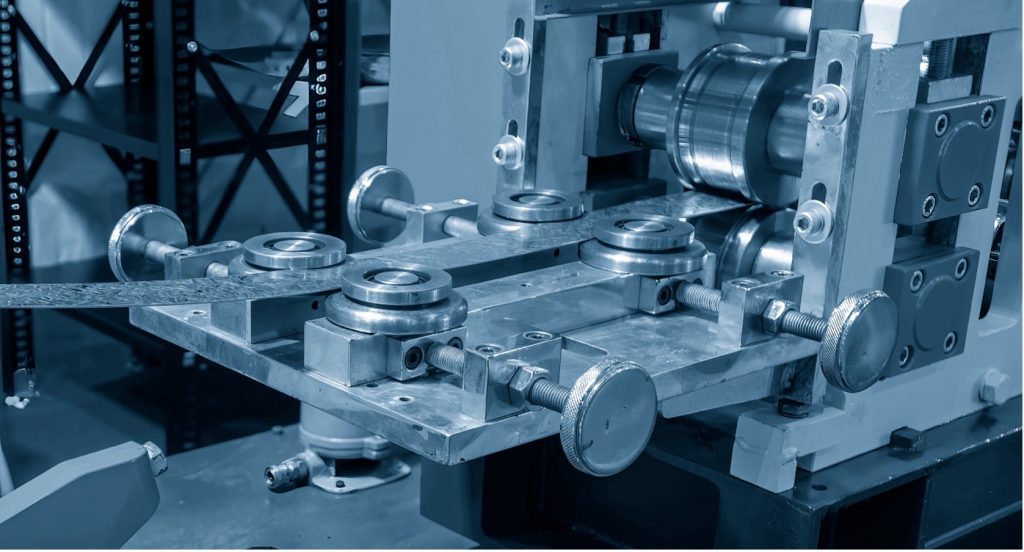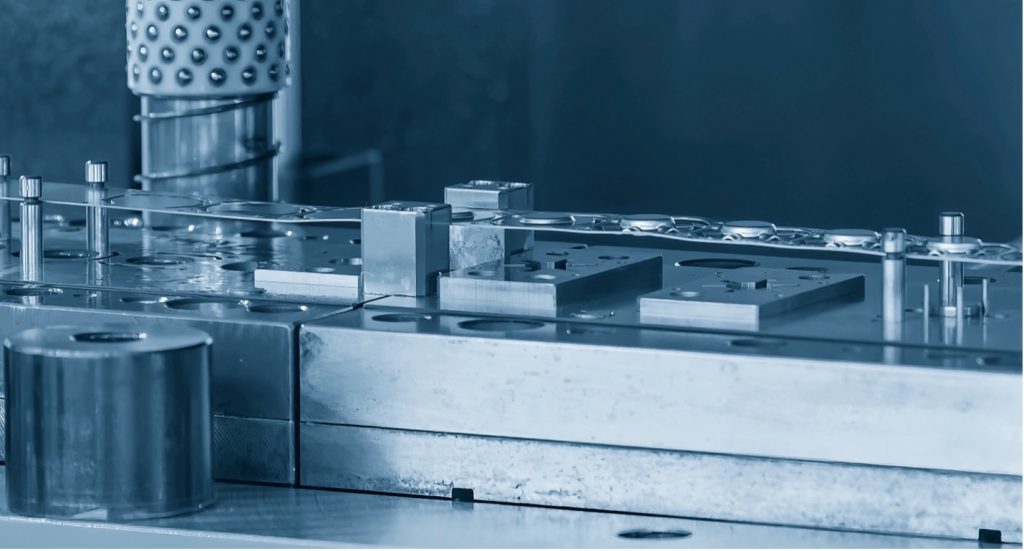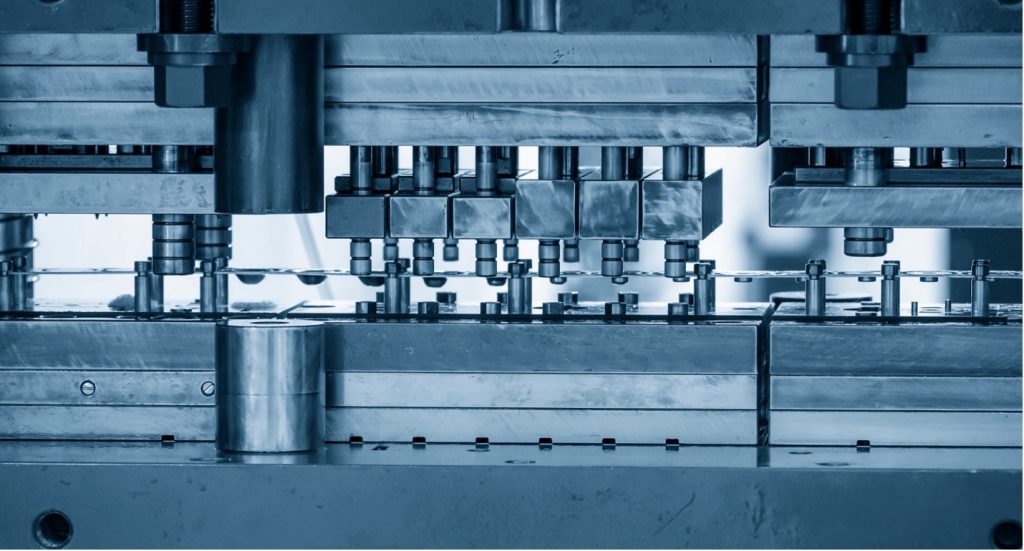

Here at Dayton Rogers, one the metal stamping processes we offer to our customers is progressive stamping. Progressive stamping involves feeding a strip of metal through a series of dies to create a finished part with every stroke of the machine. Since each cycle produces a new finished piece, this process is often used to produce high volumes of complex parts quickly and efficiently. In this guide, we will explore the ins and outs of progressive stamping, including its benefits, the equipment involved, how to select a material, and why you should choose Dayton Rogers as your next progressive stamping manufacturer.
Progressive stamping, also known as progressive die stamping, is a metalworking process that involves feeding a strip of metal through a series of dies to create a finished part. The strip of metal is fed through the dies in a continuous motion, with each die performing a specific operation on the metal until the final part is produced.
The process is highly automated and can produce high volumes of complex parts quickly and efficiently. Progressive stamping is commonly used in the automotive, aerospace, and electronics industries, among others.
Progressive stamping offers several benefits over other metalworking processes, including:
Progressive stamping requires specialized equipment to perform the various operations on the metal strip. The main components of a progressive stamping machine include:
The feeder is responsible for feeding the metal strip into the machine and ensuring that it is properly aligned for the next operation. The feeder can be either pneumatic or mechanical, depending on the type of machine.


The die set is a series of dies that are used to perform the various operations on the metal strip. Each die is responsible for a specific operation, such as cutting, bending, or forming.
The press is the main component of the progressive stamping machine. It provides the force needed to perform the operations on the metal strip. The press can be either mechanical or hydraulic.
The stripper is responsible for removing the finished part from the metal strip after each operation. It ensures that the part is released cleanly and without any damage.
Other components of a progressive stamping machine may include sensors, lubrication systems, and safety features to help streamline the stamping process.


The first step in the progressive stamping process is the design and engineering phase. This involves creating a design for the part and determining the best way to produce it using progressive stamping. This step may also involve creating prototypes to test the design and make any necessary adjustments.
Once the design is finalized, the next step is to create the tooling. This involves creating the dies that will be used to perform the various operations on the metal strip. The tooling is typically made from hardened steel to withstand the high forces and pressures involved in the stamping process.
Once the tooling is complete, it is installed in the progressive stamping machine. The machine is then set up to ensure that the metal strip is fed through the dies correctly and that the operations are performed accurately.
With the machine set up, production can begin. The metal strip is fed through the machine, and each die performs its operation on the strip until the final part is produced. The finished parts are then removed from the strip and inspected for quality.


Progressive stamping can be used with a variety of materials, including steel, aluminum, and copper. These metals are commonly used in progressive stamping due to their versatility and ability to withstand the high forces and pressures involved in the stamping process. The choice of metal depends on the specific requirements of the part being produced and the desired characteristics of the finished product.
Steel is a versatile material that can be easily formed and shaped during the progressive stamping process. It can be used to create parts with various geometries, including intricate designs and complex features. This versatility allows for the production of a wide range of parts for different industries and applications. Steel is known for its high strength-to-weight ratio, making it suitable for applications that require strong and sturdy parts. Progressive stamping can produce complex parts with tight tolerances, and steel’s strength ensures that the parts can withstand the forces and pressures involved in the stamping process. Progressive stamped parts made from steel are less likely to deform or break under stress, ensuring their longevity and reliability. Steel is readily available and relatively inexpensive compared to other metals, which makes it a cost-effective material for progressive stamping.
Aluminum is highly formable, allowing for the creation of complex shapes and designs during the progressive stamping process. It can be easily bent, formed, and shaped without sacrificing its structural integrity. This versatility makes aluminum a popular choice for parts with intricate geometries and tight tolerances. Aluminum is also known for its low density, making it significantly lighter than steel. This makes it an ideal choice for applications where weight reduction is important, such as in the automotive and aerospace industries. Aluminum is an excellent conductor of electricity, making it a preferred choice for electrical and electronic applications. Progressive stamping can be used to create intricate designs and features in aluminum parts, allowing for efficient electrical conductivity and connectivity. Aluminum has high thermal conductivity as well. This makes it suitable for applications where heat dissipation is important, such as in heat sinks or cooling systems.
Copper and copper alloys can be a good material choice for parts made with progressive stamping in cases where excellent electrical conductivity is required. Copper is known for its high electrical conductivity, making it ideal for applications in the electrical and electronics industries. Progressive stamping can be used to create intricate designs and features in copper parts, allowing for efficient electrical conductivity and connectivity. Copper alloys, which are mixtures of copper with other metals, can also offer improved strength, corrosion resistance, and other desirable properties while still maintaining good electrical conductivity.
“Exotic metals” is an umbrella term that is used to describe a group of high strength alloys whose unique properties come from the addition of a less common material. These alloys can be based in steel, aluminum, copper, titanium, magnesium, and more. Exotic metals can be used for progressive stamping, especially when the parts being formed call for a very specific set of properties that cannot be achieved with more common alloys alone. Exotic metals are typically used to make parts for the aerospace, electronics, and medical industries.


Dayton Rogers is a leading provider of progressive stamping services, with over 80 years of experience in the industry. We offer a wide range of capabilities, including in-house tooling, design, and engineering services. We also have a variety of presses capable of exerting forces up to 300 tons to accommodate different part sizes and production volumes.
One of our company’s greatest accolades is the creation of the Metalforming Design Handbook- commonly referred to as The Red Book- and the accompanying illustrated guide Example of Design Principles- also called The Black Book. The Metalforming Design Handbook provides comprehensive information on the design principles and best practices for metal stamping. It covers topics such as material selection, die design, tooling considerations, and troubleshooting common issues. The handbook serves as a valuable resource for engineers and designers involved in progressive stamping, helping them optimize the design of parts for manufacturability and efficiency. The Example of Design Principles, or The Black Book, serves as an illustrated guide that showcases real-life examples of successful progressive stamping designs. It provides practical insights into the application of design principles and demonstrates how to overcome common challenges in the stamping process. This guide is a valuable tool for designers looking for inspiration and guidance in creating progressive stamping parts. Despite first being published decades ago, our reference materials are widely used across the manufacturing industry even today.
Our extensive experience, combined with these reference materials, makes us a trusted authority in the field of progressive stamping design. By leveraging our expertise and the knowledge shared in The Red Book and The Black Book, Dayton Rogers can provide high-quality progressive stamping services and ensure that your part designs are optimized for manufacturability.
Progressive stamping is a highly efficient and cost-effective metalworking process that is used to produce high volumes of complex parts. Using the right equipment and decades of metal stamping expertise, like Dayton Rogers can provide high-quality progressive stamping services for a variety of industries. By understanding the process and the benefits it offers, you can make informed decisions about whether progressive stamping is the right choice for your manufacturing needs.
Dayton Rogers has led the metalforming industry for more than 90 years, using metal stamping, welding, and fabrication expertise to create a wide array of parts for multiple applications. Our metal stamping and automotive fabrication services create unique solutions that are integral to your firearms project’s success. If you’re ready to discuss our available metalforming methods in a consultation at no cost to you, don’t wait. Call today to speak to one of our metalforming experts about your next automotive project or schedule an in-person meeting.
Want to learn more about metal stamping and fabrication? Get your FREE copy of the Design Principles Red Book. This Design Principles booklet describes the various common conditions that occur in the fabrication of parts.
8401 West 35W Service Drive, Minneapolis, MN 55449-7260 1-800-677-8881
© 2022 Dayton Rogers. All rights reserved